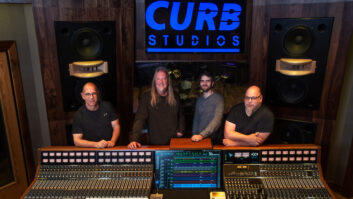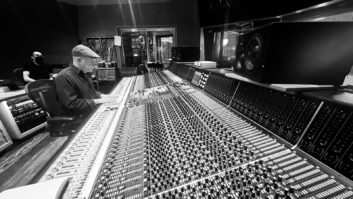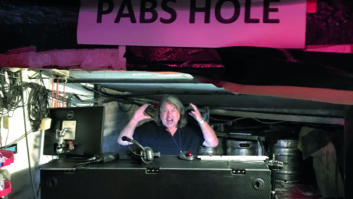One of my computer monitors has been flaking out recently. At random intervals, one of the color circuits would fail, and my screen would turn a sickening pink. It’s long past the warranty: It’s one of those old, bright, Sony 19-inch jobs that weighs about 60 pounds and costs about $2,000 when it was made eight or nine years ago (I don’t know exactly when — I bought it used). At first, it would respond to what my friend Coleman Rogers calls “the Fonzie technique” — referring to the Happy Days character who could fix anything, because he knew exactly where to whack it and how hard. But, as time went on, that became less reliable. Fans of this column know how reluctant I am to part with old gear, and although I do like this monitor, it only displays at one resolution, and with all the different types of work that I do, I came to realize it was time to retire it and replace it with a brand-new, modern, lighter, multisync model, which I was able to acquire for the piddling sum of $350.
But I figured that if I could get my old monitor repaired, then it would be nice to have an extra 19-inch monitor lying around. So I went through the phone book looking for “Macintosh monitor service” and found a place, located a distance away, but in an area I go to periodically, who promised to repair it for a fixed, payable-up-front fee of $165, assuming the tube was okay (which I knew it was). It would take two or three days, they said.
That was a month ago. I’m still waiting. They can’t really tell me whether it’s done. They tried it on a PC first, because they said they didn’t have the right cable to try it on a Mac, and it didn’t work at all. So I gave them my cable, as well as the Griffin sync adapter that has served me well on many Macs and on many monitors. They then told me that they had checked it out, soldered down everything they could see, didn’t find any bad parts, but it was working differently on different Macs, so they weren’t sure if they had fixed anything. Now, they’re asking me to bring in my own Mac so they can “synchronize” it properly. That means dismantling my whole SCSI-rat’s-nest-infested, sound-deadened computer closet, and letting them screw around with my main machine for a couple of days, while I am office-less and offline. Plus two special trips out there. They’re being very nice about the whole thing, but as I write, we’re at an impasse, although they do have the upper hand, because they have both my $165 and my monitor.
If you’ve ever tried to get an older piece of equipment, or even a newer one, repaired, then chances are good that you’ve had a similar experience. Old schematics and parts are hard to come by. Newer, proprietary parts, like VLSIs, are expensive and often scarce. Component-level repair has become almost a lost art, as service manuals increasingly show how to disconnect and remove the different sub-assemblies in our gear and decreasingly tell us what’s on them. With the price of technology constantly falling, manufacturers have taken the attitude that it’s better to replace something — a logic board, a disk drive, a tape deck — than to fix it, and we, as consumers, are forced to agree. And the type of technical expertise that is capable of fixing our increasingly complex, planned-obsolescence-prone equipment is getting harder to find.
The pro audio service business is changing as is, in fact, the meaning of the word “maintenance.” Where once we strove to keep our equipment functioning at its original performance level for the longest possible time, today’s economic and technological climate requires that our equipment constantly be updated with new firmware or software, and the time to replace it is not when it no longer fulfills its function, but when its function no longer fulfills our changing needs.
“Things aren’t built to be fixed the way they used to be,” says Coleman Rogers, who is the head technician at Alactronics, one of New England’s busiest pro audio service and installation shops. “We’re no longer seeing consoles with ribbon-cable extenders that let you take a module out and lay it on its side, or tape machines where you hit two buttons and the whole panel falls off and you can get to everything. Mackie started the trend by putting all eight channels on a single board. I recently worked with one processing unit that was impossible to take apart — I spent much more time trying to figure out how to get it apart than fixing it. Designers aren’t thinking about repair, they’re thinking about how pretty something looks.” They’re also thinking about cost — because the aforementioned Mackie consoles, of course, came out at a price point that was a fraction of what their immediate predecessors in the eight-bus field were charging.
Tom Courteau, owner of Aztech Electronics, another Boston-area repair shop, who has been in business since 1977, agrees. “It’s the new emphasis on computer-aided design and manufacture. It means that you can get terrific capabilities at affordable prices, but the stuff just isn’t made to be repaired. Even to do something as simple as cleaning the controls, which is still as important as ever, you have to take off all the knobs and take the whole thing apart, since it’s all built on one or two PC boards.”
With the possible exception of power amplifiers and tube-based guitar amps, the days when you could put an oscilloscope onto a circuit and sort out the one component that had gone bad are also largely over. Especially in applications like high-end, D/A converters, component values are much more critical, and small changes in values that may cause performance problems might not be obvious to a technician with a voltmeter. “Components interact with each other so much that a problem can be very hard to pin down,” says Rogers. “Most of the time, it’s not worth it to component-level troubleshoot, since the cost of replacing the whole board is comparable to the cost of the time that would be involved. When we replace the board, at least we know it’s fixed, which makes it a confidence thing as much as a cost thing.”
Courteau goes one step further. “When I see something that needs board-level repair or an entire new assembly, I’ll send the whole piece to the factory. That way, there’s usually a renewed warranty of some kind. It’s worth it to me and the customer.”
Many times a problem will be intermittent — like my monitor — and so the unit will have to sit on the bench a long time and be constantly monitored until it starts to exhibit whatever weirdness it’s in for. In addition, technical documents may not be as comprehensive or clear as they need to be — we all know (and I’ve written many words about) how bad user manuals can be, and service manuals are, for better or for worse, often written by the same people. So if you think it’s hard to find where the menu is for selecting the frame rate and wordclock source on that digital disk recorder, then think about the poor bench tech who’s trying to figure out what the waveform at pin 39 is supposed to look like.
Sometimes, products are just designed badly or without enough thought about how they will be used, and when they get out into the real world, they are simply bound to fail. Professional products that began life as consumer products are an obvious problem. The S-VHS transports that the original ADATs were based on, for example, were never designed to withstand the heavy high-speed use that professional studios put on them. But even the best professional gear can have problems from the beginning. Rogers cites a $3,000 box from one high-end manufacturer he’s working on that’s one-rackspace high, but it’s 15 inches deep. “That’s never going to hold up in a rack,” he says. “What were they thinking?” Courteau complains about potentiometers that are “getting cheaper, in every sense of the word. They’re the key to controlling everything, but they wear out faster, and they can’t take a hit. Unfortunately, people carry around the gear the same way they always did.”
With the shift away from component-level repair, the most common hardware issues techs encounter is with interconnects, according to Rogers. “They will always be a problem,” he says. “That’s where the Fonzie technique comes in.” Cables break, solder joints go bad, contacts oxidize. “On tape machines,” he notes, “it’s a particular problem, because you have microprocessors connected to the mechanism, so you’ve got an interface where two things can go wrong. It’s like a transducer, trying to go from a mechanical sensor to something electronic, with each one telling the other to do something.”
Both shops are reluctant to take on musical instrument repairs. Rogers has a contract with Alesis (they work on literally hundreds of ADATs each year), so he will work on that company’s synths, while Courteau says, “I avoid them. Occasionally, I’ll be talked into taking some type of keyboard, especially if it’s just a mechanical problem, but I’m not much of a computer guy, and that’s what you need for those things.” Rogers says, “The problem with MI gear is that no one wants to pay money to have it fixed. The average person who buys a keyboard is a mom who spent $100 for her 16-year-old, and when I tell them it costs $65 to fix, they say, ‘Screw that.’ An instrument is software-based and mechanically interfaces with a keyboard, so there’s that problem, and there are so many after-market software updates that it’s impossible to keep up with them. It’s just not a financially viable business for us to be in.”
Courteau, in fact, does have one specialty, which Rogers won’t touch: guitar amps. “I went to technical school in 1972, and I haven’t learned anything since,” Corteau laughs. “Tube amps have always had the same problems, either bad solder joints or thermal failures or the tubes themselves. The problem with working on this stuff was, by the late ’70s and early ’80s, we entered a long period in which the quality of the tubes declined. The manufacturing all moved offshore, and it became a major headache to get good tubes. I would cringe, because I’d be fixing some guy’s Marshall head, and even if I bench-tested the tubes, I wouldn’t know if they’d last the 90 days I was guaranteeing it. But in the last five years, they all started coming from Russia and China, and now you can get good ones without breaking the bank. We’re the only industry still using tubes, but I don’t think we’ll ever get rid of them. But no one’s learning about them anymore, so the fact that I know about them makes me a sought-after expert.”
Except for specialties like Courteau’s, Rogers sees the “repair” aspect of his field going away in the next few years. “In another four or five years, just about everyone will move away from analog and decide to go digital. The amount of time we’re going to see a piece of equipment sitting in someone’s rack will be much shorter. And the business is going to change. Training in system design and installation is going to be more important than component-level knowledge. Today, I’m on my way to a roller rink that had a guy come in and try to fix their system, but he couldn’t. They called me, and I realized that they had a single graphic equalizer feeding three of the power amps, and it was fried. The owner wanted to know how much it would be to fix it, and I told him, so he asked how much is a new one, and it wasn’t much more, so he went and bought a new one — and it’s better than the one he had.
“There’s a lot of work to be had in installation,” Rogers continues. “People are changing over to 5.1, and that needs expertise. When people buy whole systems from a place like Guitar Center, most of them have no idea where the gazintas and gazoutas are and how grounds work. I’ve had people scratching their head for two years over a problem, and I come in and find one piece of gear is plugged in wrong.”
And where are the people who are going to be doing this work in the future going to come from? Electrical engineering programs in colleges are teaching computers, not how to build, fix or install audio equipment. Another friend of mine teaches in a college with a highly respected electrical engineering department, where students are taught all of the elementals of electronics in class but never get a chance to use their basic electronics skills. When I asked my friend how many EE majors he thinks could breadboard a simple MIDI project, he said, “four or five.”
Rogers, who has been teaching maintenance and repair at a college-based recording program for more than a decade, says, “There’s a shortage of techs now. Given how busy I am, it’s obvious people are having trouble finding somebody to do service. We have a one-semester repair and maintenance course, which is okay, but some students wish it were more. Syn-Aud-Con has one of the top programs, and it gives you both theoretical and hands-on work. But you always run into problems in the field, the exceptions that you’ll never see in a classroom. There’s only so much you can do watching somebody without doing it yourself. That’s why we need internships and mentoring. Even the brightest student is initially going to make dumb mistakes until he gains real experience. It can be a slow process, doing the labor of soldering and grunt work of installation, while picking up the background material of why we’re doing things this way.
“You have to have the hands of a surgeon and be good visually — read a schematic and know what you’re supposed to be seeing by sticking an oscilloscope here or there. But you also have to know when to stop and maybe call somebody who might know more than you.”
But being a good solder jockey is only part of the gig. The similarities between the processes of becoming a good service tech and becoming a good recording engineer — a course that Rogers also teaches — are reflected in the similarities of the skill sets, he says. “There’s just as much customer handling and public relations as in studio engineering. That’s almost as important as being able to read a schematic and wield a soldering iron.”
And computers, of course, are going to continue to gain importance, so that those already in the field, according to Rogers, are going to have to retrain: “Instead of a transistor gone bad, we’re going to be looking for software conflicts,” he says. Fortunately, for me, that’s something I know how to do already, at least in my own studio. But I would be very happy if I could find an old-fashioned technician who could just give me my monitor back, with all the colors working, please.
Paul D. Lehrman is on the faculty of Tufts University, where he leaves the tech work to much more qualified people. Read about his various projects at antheil.org.







